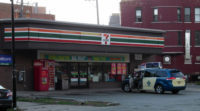Convenience stores (c-stores) are unique commercial properties in that they are usually open 24-hours, are largely cash-based businesses, can be operated by one clerk, and are conveniently located for quick in-and-out shopping, according to Chris McGoey, who specializes in security at these businesses.
The nature of this business makes it very convenient for customers. Unfortunately, this business style also makes it an attractive target for robbers and other criminals. Since 1976, the convenience store industry has made major strides toward preventing and deterring robberies. Back then, those late night businesses were an obvious robbery target because they were the only game in town. However, the c-store business has evolved since the 1970s and is now far more complex.
Modern convenience stores are sophisticated corporate designs that hardly resemble the mom and pop operations from which they evolved. In the 70s, c-stores were just beginning to operate 24-hours per day. Most stores were 2,400 square feet in size or less and did not sell gasoline. Monthly average sales volumes of $25,000 that generated a daily bank deposit of maybe $700 in cash were considered outstanding. Typical stores were located mid-block in high-density residential neighborhoods. Security consisted of a small floor safe, a manual cash register, an under counter hiding place (cigar box) for the change fund, and strategically placed anti-shoplifting convex mirrors.
Now, many other business types are operating 24-hours per day, such as large grocery stores, restaurants, gas stations and even home improvement centers. The convenience store business has definitely changed, McGoey says. Most convenience stores today are high volume corner locations that sell more gasoline than the major oil company outlets. Most food staples have been replaced with higher gross-profit snack items and fast food. C-stores now sell enormous amounts of lottery tickets, phone cards and other specialty items that produce tremendous cash flow.
When ATM machines began appearing in the early 80s, it created havoc with the store change fund because more customers started to pay with $20 bills. Stores all of a sudden need a huge change fund to make it through the day or a long holiday weekend. This new cash-flow trend has created unanticipated security problems.
Western Behavioral Sciences Institute (WBSI) published a study on robbery deterrence. This study put together the basis for today’s robbery prevention programs across the country and set out to prove the theory that convenience store robbers used a selection process before choosing targets and therefore could be deterred by making a c-store less attractive to them. The study said, in part, that robbers considered escape routes, amount of money available, number of clerks on duty, and available witnesses before they would commit to the robbery. The study went on to say that nighttime lighting and visibility were important factors to make the robber fear being “on stage” during the commission of a robbery.
As a result of the findings published in the WBSI study, according to McGoey, an entire robbery prevention program was developed by Southland Corporation (7-Eleven stores) and was implemented into approximately 6,500 convenience stores nationwide beginning in 1976. Surprisingly, the store operators poorly received the initial launch of this crime prevention program and the results reflected their lack of enthusiasm.


